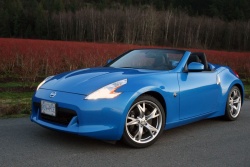 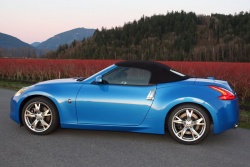 2010 Nissan 370Z Roadster. Click image to enlarge |
|
Related articles on Autos
Manufacturer’s web site
|
Review and photos by Russell Purcell
Find this vehicle in Autos’s Classified Ads
Photo Gallery:
2010 Nissan 370Z Roadster
When the 370Z first hit the streets last year it was obvious that the decision makers at Nissan were careful not to stray too far away from the design and aspirations of the outgoing 350Z, as that model had garnered a huge following and loyal customer base due to its unique styling, sporty performance, and rear-wheel drive layout. As a result, the new car is immediately recognizable as a Nissan as its overall appearance still resembles that of its forbearer.
The 370Z was penned by Canadian designer Randy Rodriguez, who credits his styling to ideas derived from the physical appearance of sharks. The influence is evident in the resulting shape of features like the car’s head and taillights, which both reflect the curved angles of a shark’s tail and dorsal fin.
The bodywork on the doors gently sweeps upwards meeting the wide rear fenders, integrated roll hoops and high rear deck. The car looks best with the top retracted, as great care was taken to conceal its structure beneath the rear deck panel giving the car a very clean and uncluttered look. In my opinion, the 370’s design represents a near-perfect blend of refinement and aggression, and is the result of the careful evolution of the previous model’s wedge shape and teardrop tail treatment. The side profile reveals that the car is a little shorter than the 350Z (4,314 mm vs. 4,246 mm), and interestingly, the wheelbase is also compressed by 100 mm. The 370Z sits almost a centimetre lower than the 350Z, and benefits from a wider track front and rear, as well as a slightly wider body. Add to this more power and a weight reduction of over 35 kilograms and you get a car that reacts quickly to driver inputs and feels planted to the road surface when driven hard.
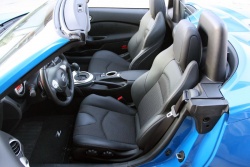 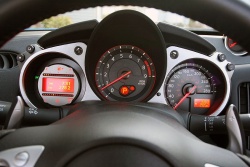 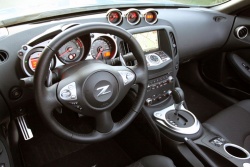 2010 Nissan 370Z Roadster. Click image to enlarge |
The interior on my test vehicle felt almost spacious as there is a little more room to stretch out in the cabin due to the increased width of the “Double Cockpit” design. The twin sport buckets seem infinitely adjustable via a pair of scroll knobs on the outboard side (which manually regulate cushion height), while power switches for recline and fore-and-aft positioning reside on the console-side of the seat edge. These highly supportive seats did an excellent job of holding me in place during aggressive manoeuvres, yet proved comfortable enough for long-distance touring as well. Both seats are equipped with heating and ventilation units as standard equipment to cool you down after a hot lap at a track day, or alternately, warm you up during an evening drive.
Instrumentation is grouped together in a compact three-gauge cluster arrangement. The large tachometer is centre stage, and sports a hood extension to shade its face from sunshine when the top is down. It also features a small digital readout to let the driver know what gear is in use and a lofty 7,500 rpm redline. A traditional white on black colour scheme offers excellent visibility, but at night, a bold orange glow is used to bring the gauges to life when you hit the pushbutton starter. All controls are driver oriented and within easy reach.
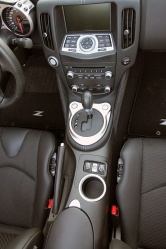 2010 Nissan 370Z Roadster. Click image to enlarge |
The three-spoke steering wheel features a host of secondary controls, but it is the column-mounted paddle shifters that beg for your attention. Some people may still prefer to use the automatic’s traditional console lever to shift via a simple side-gate, but the lightweight paddles used on this car are about the fastest units on the market and have been engineered to entertain.
The centre stack on my test car featured a seven-inch-wide multi-purpose screen (part of the optional Navigation Package) matched with Nissan’s excellent control panel. The simple switchgear for both the Bose audio and HVAC systems is well placed, intuitive to use, and exceptionally well-integrated with the overall cockpit design. A trio of secondary gauges sits atop the dash, angled in a manner to allow the driver to steal a glance without straying too far away from the task at hand.
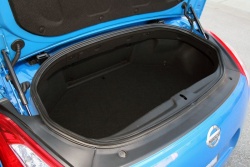 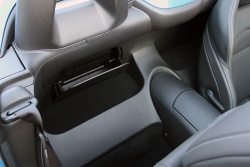 2010 Nissan 370Z Roadster. Click image to enlarge |
The car’s extra width has resulted in additional hip, shoulder and headroom, as well as the ability to carry a little more cargo. The interior volume is 1,481 litres in the Roadster (vs. 1,461 litres in the Coupe), but the need to house the fabric roof robs the trunk in the open car by 76 litres compared to the hatch configuration of the Coupe (195 litres). There are clever storage spaces tucked behind the seats to augment the map pockets in the doors, and the traditional glove box.
Unlike most of the current convertibles vying for your attention, the 2010 Nissan 370Z retains the traditional cloth-type roof design. Living in a wet Canadian climate I must admit that I like the perceived four-season robustness of the hardtop roof structure, not to mention the increased security they offer, but folding large panels of metal and glass into a compact body is a complicated engineering exercise that comes with its own set of drawbacks. Hardtop units add substantial weight and mechanical complexity, and due to their inability to become truly compact, they tend to rob the design of cargo space.
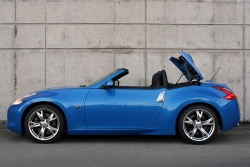 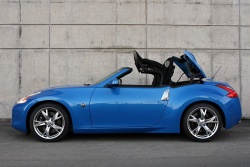 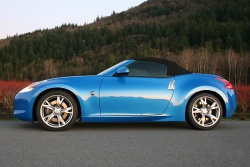 2010 Nissan 370Z Roadster. Click image to enlarge |
The addition of a hardtop can help stiffen up the chassis of a convertible vehicle, reducing the sloppy feel and cowl shake that hinders both handling and comfort in many open vehicles. Not a problem with the 370Z, as this car was engineered as a roadster from the get-go. After spending more than my fair share of time with this sporty machine doing laps around a test track in late October, I can almost guarantee that no sane person will ever refer to this car’s handling as sloppy. In a field that included the likes of handling superstars like the Audi R8 and S4, Porsche’s Panamera Turbo, the Volkswagen GTI and Hyundai Genesis Coupe, the 370Z Roadster emerged as a crowd favourite with the assembled journalists when it came to exercising some demons on the test track.
Operation of the top is accomplished with the touch of a single button. There are no latches to manually disengage and no handles to grab. The entire process is completed in about 20 seconds.
The top can be operated via the touch of a button on the door handle as long as the “intelligent key” is in your possession, even from outside the car. This is a great feature when returning to the car on a hot day as you can quickly cool the interior down by retracting the top. Perhaps you park the car in its topless state and exit the vehicle, only to spot an abundance of pigeons or a suspicious-looking individual in the parking lot. Now you can quickly put the top up without having to get in and mess around with keys and controls.
With the top down, wind turbulence is kept to a minimum by the addition of a small, clear Plexiglas dam mounted between the integrated roll hoops. While it doesn’t hinder visibility, the same cannot be said for the very wide fabric panels which act as roof pillars or the miniscule rear window. To be honest, even with the top stowed, the visibility rearward isn’t very good due to the car’s tall rear deck, wide haunches, and low seating position.
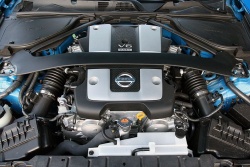 2010 Nissan 370Z Roadster. Click image to enlarge |
Both variants of the 370Z share the same engine and transmission options. The 370Z features a 3.7-litre VQ V6 engine that generates 332 horsepower and 270 lb-ft of torque. V-Valve technology adjusts the valves to maximize both performance and fuel efficiency. The standard transmission is a six-speed, close-ratio manual. Selection of the Sport Package will add to the car’s capabilities, as the standard manual transmission gains the ability to rev-match (SynchroRev Match) as you move down through the gears, ensuring that there will be instantaneous power delivery when you transition to the throttle. A similar concept (Downshift Rev Matching) is at work to automatically blip the throttle as you operate the paddle shifters on cars fitted with Nissan’s slick seven-speed automatic transmission. Either way, you better be prepared for lightning-quick response.
I was able to really test this car’s dynamic capabilities during the annual Car of the Year testing period organized by the Automobile Journalists Association of Canada’s (AJAC) Testfest event in late October. I quickly discovered that when asked to take a corner in an aggressive manner, the car’s combo of electronic safety nets (Traction Control/Vehicle Dynamic Control) interfered slightly, even when manually overridden, but I had to remind myself that this car is meant to perform the function of daily transportation, not make me a drift master. The suspension reacted quickly to my often erratic steering inputs as I terrorized the cone-lined course set up on the well-worn tarmac surface of Niagara District Airport.
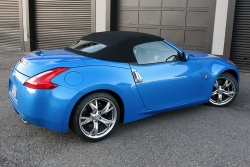 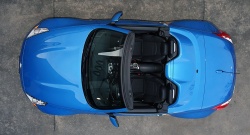 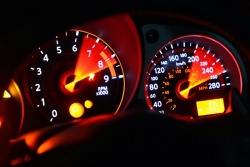 2010 Nissan 370Z Roadster. Click image to enlarge |
Acceleration is brisk and the car is exceptionally nimble and forgiving. The Sport Package brings along larger Nissan “sport” vented disc brakes (four-piston front callipers, two-piston rears) that proved durable and fade-free despite repeated torture at the AJAC test track. Handling and grip benefit from super-lightweight 19-inch RAYS forged alloy wheels and sticky Bridgestone Potenza high-performance rubber, both part of the Sport option.
While at first glance the price may seem a little high, once you consider the long list of improvements hidden beneath the car’s shapely bodywork, you will realize that the car is priced very well when compared to its rivals. In fact, I should point out that the car’s MSRP is actually less than that of the previous model by several thousand dollars, making it an excellent value in this category.
Apart from its stunning performance, every 370Z comes equipped with traction control, Vehicle Dynamic Control, 18-inch five-spoke aluminum-alloy wheels, an under-body V-brace, xenon headlights, leather-appointed sport seats with synthetic suede inserts, automatic climate control, and a Bose audio system with AM/FM/in-dash six-CD changer and illuminated steering-wheel-mounted audio controls. There are also active head restraints and a full complement of six airbags on board.
Fit-and-finish is much improved over the outgoing car, and the look, feel, and function of every switch, panel and surface is decidedly upmarket. Despite its new level of luxury Nissan is marketing the 370Z Roadster as a sports car, not a luxury convertible, as that position has been assigned to the Infiniti G37 Convertible. The enthusiast buyer will no doubt sample both vehicles, but I am quite certain that this latest Z will captivate the interest of those individuals looking to maximize their driving enjoyment.
|
Pricing: 2010 Nissan 370Z Roadster with automatic transmission
Click here for options, dealer invoice prices and factory incentives
Specifications
Competitors
Crash test results
|







 Follow Autos on Twitter
Follow Autos on Twitter



